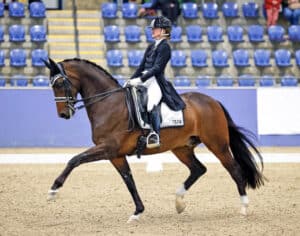Honing your seat aid skills is not easy, but to be a good rider it’s essential. National A Level dressage judge and trainer NICOLE TOUGH explains why.
As a rider, we have rein aids, leg aids and seat aids. If we want to be a good rider, then we must work to develop these aids independently from each other, and then they must work as a team.
The seat aids are the most difficult to master, and the rein aids often take over the job simply because they’re easier to use than the seat. It is extremely common for riders to use their reins to:
· slow down and/or make downward transitions
· control a loss of balance in the horse
· attempt to achieve collection
· make half-halts
· turn or bend the horse
· fiddle or put the horse’s head into a frame; and
· inadvertently put accidental pressure on the reins when learning to sit trot.
All of these uses of the rein inhibit the development of an independent seat, and thus prevent the development of the horse for dressage. To understand this, imagine the flow of traffic over a bridge. If there is an accident on the bridge, the traffic is stopped, and thus the energy flow is blocked. On a horse, the rein aids can block the flow of movement, prevent engagement, and be the cause of traffic accidents!

Although difficult to master, an independent seat is essential (Image by Rodneys Photography)
Here are six tips to help you develop that deep, independent seat:
1. Understand the job of each aid. In a downward transition, the leg aids have the job of ensuring the transition is smooth, like a car and float approaching a red light and the driver not wanting the horse to feel the float stop. The seat aids achieve the transition by the closing of the seat bones and inner thighs and the bracing of the diaphragm, and the rein aids manage the frame. Likewise in an upward transition, the leg aids achieve the transition by applying pressure with the lower leg, the seat engages so the horse doesn’t run away either in the current or the new gait; and the rein aids manage the frame.
2. It is important to know what the correct seat looks like, and have someone on the ground nagging you when you move out of that position. I have lessons every week
with my coaches, and have many idols that I try to emulate. Those riders are in my head, and I strive for their positions and effectiveness in every ride.
3. The seat aids begin and end with a strong posture. We don’t need to be really strong to be a good rider – which is why equestrian sport is one of only two in the world where men and women compete on a level playing field – but we do need the muscular endurance to hold the best posture for the entire training session.
Riders often ask ‘what exercise can I do in the gym to help me improve?’ I say, go home and watch a movie in a plank position. The plank is a body weight exercise which requires you to hold your trunk off the ground. Just like riding, this simple static exercise engages multiple muscle groups at the same time, and is effective in strengthening the core, shoulders, arms and glutes. Or, you could do what Charlotte Dujardin does and stand and squat on a gym ball for 45 minutes (but I would break a leg!) Hot tip – the more you use your core, the less you need your rein.
4. The easiest place to practise an independent seat is in the walk. Use the walk to sit as well as Charlotte Dujardin, and work on making that position your new normal. Too many riders are their laziest in walk, and yet walk is the easiest pace to sit like Charlotte.
5. Mastering dressage is not easy. Influencing a 500 kilogram animal with a mind and spirit of its own is hard enough, without trying to make it look effortless and beautiful at the same time. Investing in a saddle that wants you in the right position and therefore makes the job easier, will be the best thing you do.
6. We don’t get better at sitting trot by rising! Every sit trot step is a sit-up. That’s why it’s hard. The more you do, the better you get – but you have to practise it.
It is only through understanding, dedication, watching and learning, a coach who’s committed to telling you the truth, and so much practise, that an independent seat can be achieved. The best thing about our sport is that you improve with age. Never give up. We can all get better.
And thank you to all the coaches over the years who have helped me. Believe me, in my head I wasn’t thanking you at the time, but I thank you now!
Feature Image: Developing an independent seat as good as Charlotte Dujardin’s is something worth aspiring to (Image © FEI/Liz Gregg).



